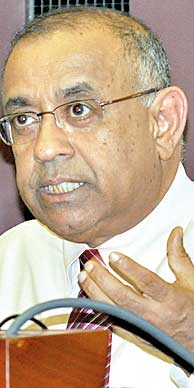.jpg)
.jpg)
 ri Lanka’s Treasury Secretary Dr. P.B. Jayasundera last week hinted at the possibility of recording a trade surplus by 2020, an economic scenario Sri Lanka has never achieved for the last six decades.
ri Lanka’s Treasury Secretary Dr. P.B. Jayasundera last week hinted at the possibility of recording a trade surplus by 2020, an economic scenario Sri Lanka has never achieved for the last six decades.
The only period Sri Lanka to record higher export earnings than imports was during the first four years of post-independence to 1952, when the world’s rubber prices were sky rocketing due to the Korean War.
Dr. Jayasundera expects to achieve this daunting target by 2020 mainly at the mercy of the developments in the apparel sector and also through import substitution industries, both of which currently have become bones of contention among economists.
“We are planning to take the apparel industry to US $ 10 billion in 2020. Not only it will be a US $ 10 billion business, our vision is to line up our apparel manufacturers among the top 10 apparel manufacturers in the world,” he told a recent forum.
Sri Lanka’s apparel sector has over the years delivered beyond expectations and in 2013 the sector topped US $ 4.3 billion in exports.
(1)(106).jpg)
The only period Sri Lanka to record higher export earnings than imports was during the first four years of post-independence to 1952
(1)(106).jpg)
Post-liberalized Sri Lanka has been consuming more than it produces and thus, the country’s import bill over the years has grown to become double its export earnings, which is now at US $ 10 billion.
Despite Sri Lanka’s exports have been growing since mid-last year, its share of gross domestic product (GDP) and its share of world’s exports have been declining.
Meanwhile, Dr. Jayasundera said Sri Lanka is estimated to have recorded US $ 1 billion in export earnings in June 2014, the highest-ever monthly export earnings to date.
However, while the Finance Ministry targets a US $ 25 billion export income for 2020, the country’s Industry and Commerce Ministry is running behind the US $ 20 billion target to be achieved in the same year, raising questions over the clarity of the government’s economic targets. Meanwhile, economists argue that Dr. Jayasundera’s apparel export target contradicts with the government’s cry for export diversification as the apparel share of total exports will go up to 50 percent from the existing 41 percent.
Another section of economists has pointed out the futility of import substitution as this ideology has been proven a total failure in country after country for the last half a century.
Instead, they have pointed out the importance of promoting exports in areas of comparative advantage and not provide artificial incentives for capital, labour and other factors of production to shift into import substitution, when it may not be in the country’s best interest.
(1)(106).jpg)
Despite Sri Lanka’s exports have been growing since mid-last year, its share of gross domestic product (GDP) and its share of world’s exports have been declining
(1)(106).jpg)
Dr. Jayasundera also said that he expects US $ 5 billion each from the IT/BPM and tourism industries and another US $ 12-15 billion from worker remittances by 2020. In 2013, IT/BPM sector recorded US $ 720 million in earnings, tourism US $ 1.7 billion and worker remittances US $ 6.4 billion.
.jpg)
![]()
 ri Lanka’s Treasury Secretary Dr. P.B. Jayasundera last week hinted at the possibility of recording a trade surplus by 2020, an economic scenario Sri Lanka has never achieved for the last six decades.
ri Lanka’s Treasury Secretary Dr. P.B. Jayasundera last week hinted at the possibility of recording a trade surplus by 2020, an economic scenario Sri Lanka has never achieved for the last six decades.(1)(106).jpg)
(1)(106).jpg)
(1)(106).jpg)
(1)(106).jpg)